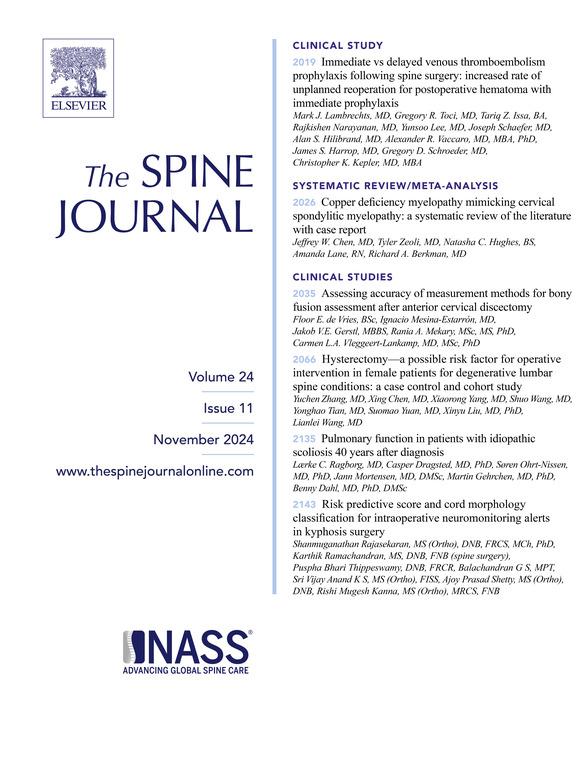56. Comparative study: platelet rich fibrin (PRF) vs radiofrequency medial ranch neurotomy (RF-MBN) for lumbar facet joint syndrome
IF 4.7
1区 医学
Q1 CLINICAL NEUROLOGY
引用次数: 0
Abstract
BACKGROUND CONTEXT
Lumbar facet joint syndrome is a prevalent cause of chronic lower back pain. Radiofrequency medial branch neurotomy (RF-MBN) alleviates pain by ablating the medial branch nerves but requires repeat procedures and may contribute to paraspinal muscle degeneration and spinal instability. Platelet-Rich Fibrin (PRF), an autologous regenerative therapy, promotes tissue healing without neural damage by releasing bioactive molecules that enhance cellular repair and neuroprotection. Unlike RF-MBN, PRF provides sustained pain relief, does not require sedation, and has no reported adverse effects.
PURPOSE
To compare the efficacy, duration of pain relief, and safety of PRF injections versus RF-MBN in the management of chronic lumbar facet joint syndrome.
STUDY DESIGN/SETTING
A retrospective cohort analysis was conducted on 160 patients diagnosed with chronic lumbar facet joint syndrome over a 10-year period. Patient records were reviewed to evaluate the outcomes of these standard clinical treatments, all performed under fluoroscopic guidance.
PATIENT SAMPLE
A total of 160 patients with confirmed lumbar facet joint syndrome were included based on clinical examination, imaging studies, and positive response to medial branch nerve blocks.
OUTCOME MEASURES
Primary outcome: Pain reduction at 12 months (VAS). Secondary outcomes: Functional improvement (ODI), adverse event rates, need for repeat procedures, and postprocedural complications. Safety outcomes included sedation-related side effects and paraspinal muscle degeneration.
METHODS
Patients were retrospectively categorized into two treatment groups: PRF Injection: Intra-articular PRF injection performed under fluoroscopic guidance every six months without sedation. RF-MBN: Medial branch nerve ablation performed under fluoroscopic guidance with sensory/motor threshold monitoring, requiring sedation, and repeated every six months.
RESULTS
Pain Relief: At 12 months, 82% of PRF patients reported >80% pain reduction compared to 60% in the RF-MBN group (p < 0.01, 95% CI: 75%-89%). Relief Duration: PRF provided sustained relief in 78% of patients beyond 12 months, while RF-MBN required repeat procedures after 10.2 months (p < 0.05, 95% CI: 72%-84%). Functional Improvement: ODI scores improved in 85% of PRF patients vs 65% in RF-MBN patients (p < 0.01, 95% CI: 78%-92%). Safety: PRF had no reported adverse events, whereas RF-MBN had a 7% complication rate, primarily transient pain flares and minor motor deficits. Sedation: PRF required no sedation, while 38% of RF-MBN patients experienced sedation-related side effects, prolonging recovery. Muscle Stability: No paraspinal muscle degeneration was observed in PRF patients, whereas RF-MBN patients demonstrated an increased risk of spinal instability due to nerve ablation.
CONCLUSIONS
PRF is a safe, effective, and longer-lasting treatment for lumbar facet joint syndrome, providing significant pain relief and functional improvement without the need for sedation or neural damage. Unlike RF-MBN, PRF preserves paraspinal muscle integrity, reducing the risk of spinal instability. As a retrospective study, selection bias and documentation inconsistencies may influence results. Future randomized controlled trials with larger sample sizes and extended follow-up periods are warranted to further validate these findings, optimize PRF application techniques, and assess its long-term impact on functional mobility and healthcare costs.
FDA Device/Drug Status
This abstract does not discuss or include any applicable devices or drugs.
56. 比较研究:富血小板纤维蛋白(PRF)与射频内侧牧场神经切开术(RF-MBN)治疗腰椎小关节综合征
背景背景腰椎关节突关节综合征是引起慢性腰痛的常见原因。射频内侧支神经切开术(RF-MBN)通过切除内侧支神经减轻疼痛,但需要重复手术,并可能导致棘旁肌退变和脊柱不稳定。富血小板纤维蛋白(PRF)是一种自体再生疗法,通过释放增强细胞修复和神经保护的生物活性分子,促进组织愈合而不损伤神经。与RF-MBN不同,PRF提供持续的疼痛缓解,不需要镇静,也没有报道的不良反应。目的比较PRF注射与RF-MBN治疗慢性腰椎小关节综合征的疗效、疼痛缓解时间和安全性。研究设计/背景对160例诊断为慢性腰椎小关节综合征的患者进行了10年的回顾性队列分析。回顾患者记录以评估这些标准临床治疗的结果,所有治疗均在透视指导下进行。患者SAMPLEA根据临床检查、影像学检查和对内侧支神经阻滞的阳性反应,共纳入160例确诊为腰椎小关节综合征的患者。主要结果:12个月时疼痛减轻(VAS)。次要结局:功能改善(ODI)、不良事件发生率、需要重复手术和术后并发症。安全性结果包括镇静相关的副作用和棘旁肌变性。方法回顾性将患者分为两组:PRF注射组:在透视引导下关节内PRF注射,每6个月进行一次,无镇静。RF-MBN:在透视引导下进行内侧支神经消融,伴有感觉/运动阈值监测,需要镇静,每六个月重复一次。结果西班牙缓解:12个月时,82%的PRF患者报告疼痛减轻80%,而RF-MBN组为60% (p < 0.01, 95% CI: 75%-89%)。缓解持续时间:PRF在超过12个月的患者中提供了78%的持续缓解,而RF-MBN在10.2个月后需要重复手术(p < 0.05, 95% CI: 72%-84%)。功能改善:85% PRF患者的ODI评分改善,而RF-MBN患者的ODI评分改善为65% (p < 0.01, 95% CI: 78%-92%)。安全性:PRF无不良事件报道,而RF-MBN有7%的并发症发生率,主要是短暂的疼痛发作和轻微的运动缺陷。镇静:PRF不需要镇静,而38%的RF-MBN患者出现镇静相关副作用,延长了恢复时间。肌肉稳定性:PRF患者未观察到棘旁肌退变,而RF-MBN患者由于神经消融而表现出脊柱不稳定的风险增加。结论sprf是一种安全、有效、持久的治疗腰椎小关节综合征的方法,在不需要镇静或神经损伤的情况下,可以显著缓解疼痛和改善功能。与RF-MBN不同,PRF保留了棘旁肌的完整性,减少了脊柱不稳定的风险。作为一项回顾性研究,选择偏差和文献不一致可能影响结果。未来有必要进行更大样本量和更长随访期的随机对照试验,以进一步验证这些发现,优化PRF应用技术,并评估其对功能流动性和医疗成本的长期影响。FDA器械/药物状态本摘要不讨论或包括任何适用的器械或药物。
本文章由计算机程序翻译,如有差异,请以英文原文为准。
求助全文
约1分钟内获得全文
求助全文
来源期刊

Spine Journal
医学-临床神经学
CiteScore
8.20
自引率
6.70%
发文量
680
审稿时长
13.1 weeks
期刊介绍:
The Spine Journal, the official journal of the North American Spine Society, is an international and multidisciplinary journal that publishes original, peer-reviewed articles on research and treatment related to the spine and spine care, including basic science and clinical investigations. It is a condition of publication that manuscripts submitted to The Spine Journal have not been published, and will not be simultaneously submitted or published elsewhere. The Spine Journal also publishes major reviews of specific topics by acknowledged authorities, technical notes, teaching editorials, and other special features, Letters to the Editor-in-Chief are encouraged.
 求助内容:
求助内容: 应助结果提醒方式:
应助结果提醒方式:


